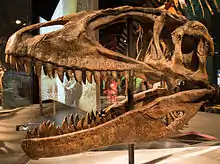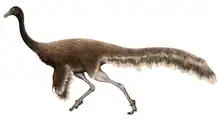| Carcharodontosaurids Temporal range: Possible Campanian record | |
|---|---|
 | |
| Reconstructed Carcharodontosaurus skull, Science Museum of Minnesota | |
| Scientific classification | |
| Domain: | Eukaryota |
| Kingdom: | Animalia |
| Phylum: | Chordata |
| Clade: | Dinosauria |
| Clade: | Saurischia |
| Clade: | Theropoda |
| Clade: | †Carcharodontosauria |
| Family: | †Carcharodontosauridae Stromer, 1931 |
| Subgroups | |
| |
| Synonyms | |
| |
Carcharodontosauridae (carcharodontosaurids; from the Greek καρχαροδοντόσαυρος, carcharodontósauros: "shark-toothed lizards") is a group of carnivorous theropod dinosaurs. In 1931, Ernst Stromer named Carcharodontosauridae as a family, which, in modern paleontology, indicates a clade within Carnosauria. Carcharodontosaurids include some of the largest land predators ever known: Giganotosaurus, Mapusaurus, Carcharodontosaurus, and Tyrannotitan all rivaled Tyrannosaurus in size. Estimates give a maximum weight of 8–10 metric tons (8.8–11.0 short tons) for the largest carcharodontosaurids, while the smallest carcharodontosaurids were estimated to have weighed at least 500 kilograms (1,100 lb).
Evolution

Along with the spinosaurids, carcharodontosaurids were the largest predators in the early and middle Cretaceous throughout Gondwana, with species also present in North America (Acrocanthosaurus), Europe (Concavenator) and Asia (Shaochilong).[5] Carcharodontosaurids range throughout the Cretaceous from the Barremian (127-121 million years ago) to the Turonian (93-89 million years ago). Past the Turonian, they were replaced by the smaller abelisaurids in Gondwana and by tyrannosaurids in North America and Asia.[6][7] While some teeth and a maxilla discovered in Maastrichtian deposits of Brazil.[8][9] this identification has been subsequently rejected and the material assigned to abelisaurids after better examination,[10] and there are no reliable records of carcharodontosaurs in South America beyond the end of the Turonian.[6] In December 2011, Oliver W. M. Rauhut described a new genus and species of carcharodontosaurid from the Late Jurassic (late Kimmeridgian to earliest Tithonian faunal stage, about 154-150 million years ago) of Tendaguru Formation, southeastern Tanzania. This genus, Veterupristisaurus represents the oldest known carcharodontosaurid.[11]
Classification
The family Carcharodontosauridae was originally named by Ernst Stromer in 1931 to include the single newly discovered species Carcharodontosaurus saharicus. A close relative of C. saharicus, Giganotosaurus, was added to the family when it was described in 1995. Additionally, many paleontologists have included Acrocanthosaurus in this family (Sereno et al. 1996, Harris 1998, Holtz 2000, Rauhut 2003, Eddy & Clarke, 2011, Rauhut 2011), though others place it in the related family Allosauridae (Currie & Carpenter, 2000; Coria & Currie, 2002). Carcharodontosaurids are characterized by the following morphological characters : Dorsoventral depth of anterior maxillary interdental plates more than twice anteroposterior width, squared, sub-rectangular anterior portion of the dentary, teeth with wrinkled enamel surfaces, presence of four premaxillary alveoli and a premaxillary body taller than long in lateral aspect, opisthocoelous cervical vertebrae with neural spines more than 1.9 times the height of the centrum, large, textured rugosities on the lacrimal and postorbital formed by roofing and forming broad orbital shelves, and a proximomedially inclined femoral head.[12][13] With the discovery of Mapusaurus in 2006, Rodolfo Coria and Phil Currie erected a subfamily of Carcharodontosauridae, the Giganotosaurinae, to contain the most advanced South American species, which they found to be more closely related to each other than to the African and European forms. Coria and Currie did not formally refer Tyrannotitan to this subfamily, pending a more detailed description of that genus, but noted that based on characteristics of the femur, it may be a gigantosaurine as well.[14]
In 1998 Paul Sereno defined Carcharodontosauridae as a clade, consisting of Carcharodontosaurus and all species closer to it than to either Allosaurus, Sinraptor, Monolophosaurus, or Cryolophosaurus. Therefore, this clade is by definition outside of the clade Allosauridae. The cladogram below follows the analysis of Brusatte et al., 2009.[5]
| Carcharodontosauridae |
| |||||||||||||||||||||||||||||||||||||||
Cladogram after Ortega et al., 2010[12]
| Carcharodontosauridae |
| |||||||||||||||||||||||||||||||||||||||
Cladogram after Novas et al., 2013[4]
| |||||||||||||||||||||||||||||||||||||||||||||||||
Cladogram after Canale et al., 2022[2]
| Carcharodontosauridae |
| |||||||||||||||||||||||||||||||||||||||||||||||||||||||||

The placement of Acrocanthosaurus is unclear, with most[13] researchers favoring Carcharodontosauridae and others favoring Allosauridae. In 2011, a redescription of Kelmayisaurus by Stephen L. Brusatte, Roger B. J. Benson and Xing Xu found it to be valid genus of Carcharodontosauridae. A phylogenetic analysis of Tetanurae recovered K. petrolicus as a basal carcharodontosaurid in a trichotomy with Eocarcharia and a clade comprising more derived carcharodontosaurids.[1] Bahariasaurus has also been proposed as a carcharodontosaurid, but its remains are too scarce to be certain.
Carcharodontosaurids have been proposed as more closely related to abelisaurids, as opposed to the allosaurids. This is due to these two clades sharing some cranial features. However, these similarities appear to derive from parallel evolution between these two groups. A larger number of cranial and postcranial characters support their relationship with allosaurids.
Paleobiology
Growth
Studies of the Argentinian taxon Meraxes suggest that these allosauroids were slow-growing, taking as long as 30-40 years to reach maturity. The maximum age for the holotype specimen was estimated to be roughly 50 years at the time of its death, making it the oldest known non-avian theropod. Unlike Tyrannosaurus, to which its growth has been compared, this carcharodontosaurid kept growing throughout its life.[15]
In 2021 the paleontologist Andrea Cau proposed that Scipionyx, formally classified as a compsognathid, was instead an hatchling carcharodontosaurid. He compared it with Allosaurus and Acrocanthosaurus, finding it more similar to the carcharodontosaurid than the allosaurid.[16]
References
- 1 2 Stephen L. Brusatte; Roger B. J. Benson; Xing Xu (2012). "A reassessment of Kelmayisaurus petrolicus, a large theropod dinosaur from the Early Cretaceous of China" (PDF). Acta Palaeontologica Polonica. 57 (1): 65–72. doi:10.4202/app.2010.0125. S2CID 53387460. Archived from the original (PDF) on 2011-12-18. Retrieved 2011-04-28.
- 1 2 3 Canale, J.I.; Apesteguía, S.; Gallina, P.A.; Mitchell, J.; Smith, N.D.; Cullen, T.M.; Shinya, A.; Haluza, A.; Gianechini, F.A.; Makovicky, P.J. (2022-07-07). "New giant carnivorous dinosaur reveals convergent evolutionary trends in theropod arm reduction". Current Biology. 32 (14): 3195–3202.e5. doi:10.1016/j.cub.2022.05.057. PMID 35803271.
- ↑ Carrano, M.T.; Benson, R.B.; Sampson, S.D. (2012). "The phylogeny of Tetanurae (Dinosauria: Theropoda)". Journal of Systematic Palaeontology. 10 (2): 211–300. doi:10.1080/14772019.2011.630927. S2CID 85354215.
- 1 2 Novas, Fernando E. (2013). "Evolution of the carnivorous dinosaurs during the Cretaceous: The evidence from Patagonia". Cretaceous Research. 45: 174–215. doi:10.1016/j.cretres.2013.04.001. hdl:11336/102037.
- 1 2 Brusatte, S.; Benson, R.; Chure, D.; Xu, X.; Sullivan, C.; Hone, D. (2009). "The first definitive carcharodontosaurid (Dinosauria: Theropoda) from Asia and the delayed ascent of tyrannosaurids" (PDF). Naturwissenschaften. 96 (9): 1051–8. Bibcode:2009NW.....96.1051B. doi:10.1007/s00114-009-0565-2. hdl:20.500.11820/33528c2e-0c9c-4160-8693-984f077ee5d0. PMID 19488730. S2CID 25532873.
- 1 2 Meso, J.G.; Juárez Valieri, R.D.; Porfiri, J.D.; Correa, S.A.S.; Martinelli, A.G.; Casal, G.A.; Canudo, J.I.; Poblete, F.; Dos Santos, D. (2021-09-01). "Testing the persistence of Carcharodontosauridae (Theropoda) in the Upper Cretaceous of Patagonia based on dental evidence". Cretaceous Research. 125: 104875. doi:10.1016/j.cretres.2021.104875. hdl:11336/183886. ISSN 0195-6671.
- ↑ Novas, de Valais, Vickers-Rich, and Rich. (2005). "A large Cretaceous theropod from Patagonia, Argentina, and the evolution of carcharodontosaurids." Naturwissenschaften,
- ↑ Rodrigo P. Fernandes de Azevedo; Felipe Medeiros Simbras; Miguel Rodrigues Furtado; Carlos Roberto A. Candeiro & Lílian Paglarelli Bergqvist (2013). "First Brazilian carcharodontosaurid and other new theropod dinosaur fossils from the Campanian–Maastrichtian Presidente Prudente Formation, São Paulo State, southeastern Brazil". Cretaceous Research. 40: 131–142. doi:10.1016/j.cretres.2012.06.004.
- ↑ Carlos Roberto Candeiro; Philip Currie; Lílian Bergqvist (2012). "Theropod teeth from the Marília Formation (late Maastrichtian) at the Paleontological Site of Peirópolis in Minas Gerais State, Brazil". Revista Brasileira de Geociências. 42 (2): 323–330. doi:10.5327/z0375-75362012000200008.
- ↑ Delcourt, R.; Grillo, O.N. (2017). "Carcharodontosaurids remained extinct in the Campanian-Maastrichtian: Reassessment of a fragmentary maxilla from Presidente Prudente Formation, Brazil". Cretaceous Research. 84: 515–524. doi:10.1016/j.cretres.2017.09.008.
- ↑ Rauhut, Oliver W. M. (2011). "Theropod dinosaurs from the Late Jurassic of Tendaguru (Tanzania)". Special Papers in Palaeontology. 86: 195–239.
- 1 2 Ortega, F.; Escaso, F.; Sanz, J. L. (2010). "A bizarre, humped Carcharodontosauria (Theropoda) from the Lower Cretaceous of Spain" (PDF). Nature. 467 (7312): 203–206. Bibcode:2010Natur.467..203O. doi:10.1038/nature09181. PMID 20829793. S2CID 4395795. Archived from the original (PDF) on 2018-10-08. Retrieved 2016-12-06.
- 1 2 Eddy, DR; Clarke, JA (2011). "New Information on the Cranial Anatomy of Acrocanthosaurus atokensis and Its Implications for the Phylogeny of Allosauroidea (Dinosauria: Theropoda)". PLOS ONE. 6 (3): e17932. Bibcode:2011PLoSO...617932E. doi:10.1371/journal.pone.0017932. PMC 3061882. PMID 21445312.
- ↑ Coria, R.A.; Currie, P.J. (2006). "A new carcharodontosaurid (Dinosauria, Theropoda) from the Upper Cretaceous of Argentina". Geodiversitas. 28 (1): 71–118.
- ↑ "T. rex had huge growth spurts, but other dinos grew slow and steady: By cutting into fossils and examining growth rings, scientists learned how predatory dinosaurs got so big". ScienceDaily.
- ↑ "Comments on the Mesozoic theropod dinosaurs from Italy". ResearchGate. Retrieved 2021-12-27.
External links
- Carcharodontosauridae/Abelisauridae Archived 2021-04-28 at the Wayback Machine
- Carcharodontosauridae/Abelisauridae 2 Archived 2021-04-30 at the Wayback Machine

.jpg.webp)












